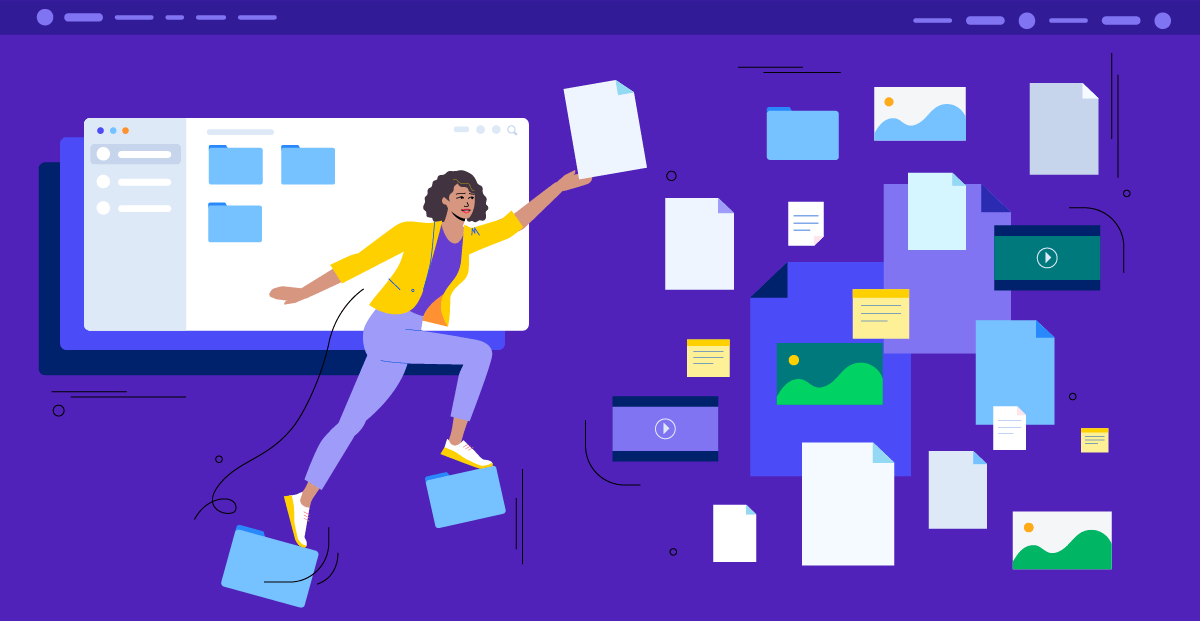Digital Asset Management—Reduce Clutter, Focus on What Matters

Finding a needle in a haystack is child’s play for those of us who keep all our personal and work-related files on their desktop. Or so it may seem.
I, for one, admire anyone who can easily locate anything that lurks hidden among a plethora of colorful icons scattered across an overly cluttered desktop background without losing their temper—or getting a surge of cortisol rushing through their bloodstream.
While most of us do try to keep things tidy and well organized, we can all agree—the number of files and the variety of formats we store on our computers keep piling up. And sometimes we all wonder if there is a better way to keep images, videos and documents organized and easier to share not only with friends and family, but more importantly with our peers, managers, prospects and customers.
And it doesn't end there.
The cost associated with recreating lost or misplaced work or simply keeping everything and everyone in sync can easily drain your resources, leaving no energy to tackle important stuff, let alone enough headroom to grow and innovate.
Here is where Digital Asset Management comes into play.
What is Digital Asset Management (DAM)?
Digital Asset Management is both a business process and a technology foundation that enables organizations to centrally store, organize, manage and publish digital assets across channels. DAM platforms can be deployed on-premise or as SaaS applications and can be seamlessly integrated with most business systems. DAM integration makes powerful digital asset management capabilities such as image transformation, video transcoding, text recognition, document analysis, auto-tagging and batch processing as well as AI-driven image optimization easily accessible by end users.

DAM systems also enable IT to streamline the ongoing management of digital assets, leveraging a central repository that can scale as needed. It also gives the ability to tap into workflows, ensure content governance and get instant access to powerful capabilities that otherwise would be quite expensive to build, perfect and scale in-house.
Is DAM a CMS?
Digital Asset Management (DAM) platforms and Content Management Systems (CMS) share many similarities. A DAM platform can serve as dedicated vehicle to deliver digital assets to the end user (think image bank websites, where the digital assets are content). But where DAMs truly shine is when they are integrated with your CMS or DXP to help turn boring, plain text into visually rich experiences where content serves more than one purpose.
What is the best DAM platform for my business?
And, because bringing a DAM platform onboard will have an immediate and long-term impact that spans across multiple teams, you should carefully consider whether you really need it.
Things to consider:
- Content Lifecycle: Do you employ external contributors or multiple internal teams who need to stay aligned and in sync throughout the entire asset creation lifecycle?
- Cadence: How often does your org create, transform or distribute digital assets such as web images, campaign banners, whitepapers, eBooks, technical documents, press releases and videos, etc.?
- Delivery: Do you need to keep assets in sync across channels (e.g. web, mobile, intranet, B2B and B2E portals)?
- Self-service: Can you compress existing workflows and reduce low-value tasks by automating common tasks?
- Security and Compliance: Do you need to implement effective controls to protect company assets in order to meet contractual, compliance or regulatory compliance?
Whether you have employed a custom-built CMS or are just embarking on a journey to build a composable DXP, DAM should be one of the key areas of focused attention. It can have a visible impact on both your marketing team’s productivity and the operational efficiency of the entire organization.
What are the benefits of adopting a company-wide DAM?
For you as an IT manager, or someone who needs to carefully architect and plan your organization’s online presence for the next, say, five years, DAM is surely one of the components of your composable DXP that you should not ignore.

- DAM keeps all assets centrally stored, organized and easy to find. This simplifies management, helps with scalability and, let’s face it, gives you the ability to tap in hundreds of dedicated developers who regularly release new functionalities.
- Digital Asset Management platforms play nice with your security and compliance needs—offering you very granular controls over permissions, user accounts and workflows. DAM platforms also make bringing an external contributor onboard very easy.
- DAM brings powerful tools closer to the end user, thus reducing the resource overhead and the financial burden associated with the need to invest in and support expensive desktop image authoring software.
- And last but not least, you can enable marketing to eliminate low-value tasks so they can focus on what matters. Reducing your creative team’s workload is a breeze when you have the ability to effortlessly transform and repurpose digital assets with user-friendly tools and AI-driven automation.
Augmenting your existing CMS or DXP solution with DAM capabilities can help improve the end-user experience thanks to the built-in asset optimization routines (think great visual quality in a smaller package) and the lightning-fast asset delivery regardless of the user device or location (think, wow, that was awesomely fast).
This in turn can have an impact on the conversion rates, customer loyalty and more. We will cover those topics in another blog post, so stay tuned.
Sitefinity provides two DAM integration options from trusted vendors, Cloudinary and Frontify, that are guaranteed to help you get up and running in minutes without breaking a sweat—or the bank. Let’s dig into it.
How to Get Started with DAM in Sitefinity
Sitefinity fuels the successful web presence of thousands of businesses and is at the core of many enterprise organizations’ digital experiences.
Many of our existing customers still feel at home with Sitefinity’s built-in capabilities to upload, store and organize media.
Leveraging straightforward partner integrations from trusted vendors can deliver a surge of power to your team’s productivity and agility and the low barrier of entry will provide the much-needed headroom to grow.
Both Cloudinary and Frontify come with a price tag that is guaranteed to keep your COO happy.
And, Cloudinary and Frontify integration is a snap in Sitefinity 14.1.
From an integration point of view, both Cloudinary and Frontify are very similar. Choosing one over the other will depend on your long-term goals:
- Is image transformation, optimization and delivery your main focal point?
Or:
- Do you look at a DAM platform as a stepping stone to build, manage and deliver a consistent brand image across all online and offline channels?
We will cover main use cases and other subtle differences in another post, but the key takeaway is that both platforms are very, very powerful, extremely scalable and easy to use.
Both integrations are available to Sitefinity customers running version 14.1. Customers on previous Sitefinity versions should upgrade to the latest release.
If you are considering Sitefinity as a replacement to your existing CMS, an online sandbox trial can help you build a proof of concept or try the integration without additional overhead.
In a series of upcoming blog posts, we will cover some practical usage of DAM and how it can augment your existing content and reveal which AI-driven DAM capabilities can help boost the productivity of marketing and the effectiveness of the marketing campaigns.
Until then, feel free to learn more about Sitefinity, get some hands-on training or simply dive into the immersive power of the platform by launching a free trial.

